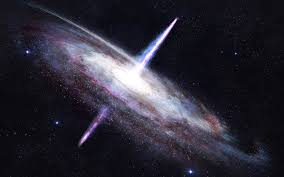
Quasars
A we look further into space, we look backwards in time. The most distant objects - about 12 billion light years away - we can see are also the most energetic - emitting up to 100 times the energy output of the Milky Way. They are compact sources emitting massive amounts of electromagnetic radiation, and are believed to be as a result of an accretion disk of dust and gas being heated and falling into a supermassive black hole at the centre of a galaxy formed as a result of the collision of smaller galaxies. As it falls, radiation is emitted preferentially along the axes of rotation.
